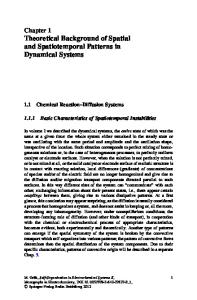Evolving Spatial Patterns
- PDF / 244,404 Bytes
- 36 Pages / 547.087 x 737.008 pts Page_size
- 50 Downloads / 371 Views
Shashi Shekar • Hui Xiong (Eds.)
Encyclopedia of GIS
With 723 Figures and 90 Tables
123
S HASHI S HEKHAR McKnight Distinguished University Professor Faculty of Computer Science and Engineering University of Minnesota Minneapolis, MN 55455 USA
H UI X IONG Assistant Professor Management Science and Information Systems Department Rutgers Business School Newark and New Brunswick Rutgers, the State University of New Jersey Newark, NJ 07102 USA
Library of Congress Control Number: 2007933825
ISBN: 978-0-387-35973-1 This publication is available also as: Print publication under ISBN: 978-0-387-30858-6 and Print and electronic bundle under ISBN: 978-0-387-35975-5 © 2008 SpringerScience+Buisiness Media, LLC. All rights reserved. This work may not be translated or copied in whole or in part without the written permission of the publisher (Springer Science+Business Media, LLC., 233 Spring Street, New York, NY 10013, USA), except for brief excerpts in connection with reviews or scholarly analysis. Use in connection with any form of information storage and retrieval, electronic adaptation, computer software, or by similar or dissimilar methodology now known or hereafter developed is forbidden. The use in this publication of trade names, trademarks, service marks, and similar terms, even if they are not identified as such, is not to be taken as an expression of opinion as to whether or not they are subject to proprietary rights. springer.com Printed on acid free paper
SPIN: 11420118 2109letex – 5 4 3 2 1 0
To our families . . .
Foreword by Brian Berry
The publication of a definitive Encyclopedia of GIS that lays out many of the computer science/mathematics foundations of the field is a major event, the culmination of a half century of development. I was part of the earliest stirrings in the mid-1950s. A small group of geography graduate students at the University of Washington, William Garrison’s “space cadets,” began to assemble what became the foundations of contemporary spatial analysis and to refocus mathematical cartography while working with civil engineer Edgar Horwood on his attempts to use the printers of the time to produce grey-shaded maps. Our attention was captured by Sputnik, however, we didn’t anticipate that the US’s response, the rapid development of NASA and satellite systems, would be the key to the equally rapid development of remote sensing, or that global positioning would rewrite cartography. Among the innovations of the time were Torsten Hägerstrand’s first simulation models of space-time diffusion processes and early econometric interest in spatial autocorrelation. Both themes are now central to spatial analysis. The GIS focus shifted when Garrison, Marble and I relocated to the Chicago region. Garrison and I helped fund civil engineer Howard Fisher’s first generation computer graphics software, SYMAP I, and Marble and I organized NSF workshops to spread the word and drew together an initial overview of the field in Spatial Analysis. Fisher took his ideas to the Ford Foundation and a subseq
Data Loading...










